Self-Similar Functional Circuit Models of Arteries and Deterministic Fractal Operators: Theoretical Revelation for Biomimetic Materials
Abstract
:1. Introduction
2. Models and Methods
2.1. Infinite-Level Physical Model and the Infinite-Level Self-Similar Functional Circuit Models of Arteries
- The first step is the mechanical-electrical analogy of the arteries. According to the classical elastic-cavity model, there are three main influencing factors of blood flow in the arteries. The factors can be analogized as three kinds of circuit elements:
- 1.
- The flow induced by the longitudinal inertia of the blood flow is , which can be mimicked to the current on the inductance element L;
- 2.
- The transverse flow caused by the compliance of vascular wall is , which can be equivalent to the current on the capacitor element C;
- 3.
- The flow caused by blood viscosity can be equivalent to the current on the resistance element R.
The comparison relations of respective parameters are shown in Table 1.There are quantitative correlations in detail between the parameters of equivalent electrical elements and the physical parameters of arterial blood flow [38].- 1.
- 2.
- 3.
where, and are the constant coefficients, r is the radius of the vessel section, and h is the thickness of the vessel wall.Note that when we vary the electrical parameters, the corresponding blood flow parameters also change. Therefore, different physiological states of arterial vessels can be simulated by adjusting these electrical parameters. Primarily, atherosclerotic diseases are related to the parameter of vessel wall compliance. With different capacitors, arterial blood flow states under the different conditions of atherosclerosis can be mimicked. - The second step is to abstract the physical model with an infinite number of micro-elastic cavities. Referring to the idea of mathematical localization analysis in calculus, the single-level elastic cavity can be micro-differentiated into a combination of infinite-level micro-elastic cavities (micro-segment ). In this way, blood vessels can be regarded as a physical structure model with infinite-level micro-elastic cavities, as shown in Figure 2d.To simplify the problem, the arterial segments are treated as homogeneous. The elasticity of the tube wall, blood viscosity, and inertia are uniformly distributed along the longitudinal direction of the vessel. Thus, the physical parameters of wall compliance, blood viscosity, and inertia are constant in all micro-elastic cavities . Figure 2d is the physical model of blood flow in this paper.
- The third step is to abstract the self-similar analogous circuit, i.e., the ISFCM, from the physical model. According to the mechanical-electrical analogy, let , the infinite-level analogous circuits of the infinite-level micro-elastic cavities can be obtained, as shown in Figure 2e,f.In Figure 2, and are the input and output voltages or blood pressures, respectively. and are the input and output currents or blood flow rates, respectively. This paper mainly focuses on the input voltage and output current response of the circuit under the regulation of respective functional components.In Figure 3, an input power supply voltage is introduced at the beginning of the equivalent arterial circuit. A resistor representing the peripheral resistance of blood vessels is added at the end to form a closed circuit. To analyze the regulation mechanism induced by the arterial basic analogous elements and combined structural patterns, we assumed that the electrical potential at the tail of the artery is zero, and the resistance R at the tail is ignored. Then, the equivalent circuit of the aorta is obtained, as shown in Figure 3a. Similarly, the arteriolar equivalent circuit can be derived, as shown in Figure 3c.Based on the equivalent transformation from Figure 3a,c into Figure 3b,d, it can be seen that the analogous circuit has self-similarity. Such infinite-level functional circuits are termed infinite-level self-similar functional circuits (ISFC), and for the reason that the circuits are utilized to mimic arterial blood flow behavior, we call it an infinite-level self-similar functional circuit model (ISFCM).On the other hand, the infinite-level self-similar functional circuit is also termed fractal functional circuit (FFC). The FFC in Figure 3 has infinite-level self-similar characteristics: for the aorta and the same with arteriole, each level of the circuit is composed of inductance and capacitance, and the next level infinitely repeats the previous level in a step shape. The FFCs of the arteriole and aorta have the same topological structures, but each level contains different components. Apart from capacitive elements, the aorta and arteriole contain inductance and resistance elements, respectively. Note that the FFC is a functional fractal with a specific physical analogous function and is different from general geometric fractal. The functional fractal is a kind of infinite-level self-similar functional structure without considering geometric scale invariance and fractal dimension.In the above analysis, the structure of finite-level models is stochastic. However, once the infinite-level circuit is abstracted, a new structural form can be derived, namely the infinite-level self-similar and functional fractal structural pattern shown in Figure 3. New concepts can be extracted with the infinite-level self-similar and fractal features, and new methods can be developed to describe the blood flow. Surprisingly, the research result can reach the unexpectedly exquisite and brief form.
2.2. Fractal Hypercell of the FFC in the ISFCM
2.3. Fractal Admittance Operators Describing the Time-Varying Blood-Flow Response of the Arterial ISFCM
- The first step is to express the admittance characteristics of the basic physical components included in the fractal circuit using an operator :where and respectively represent the current and voltage in the time domain on the electrical element, p is the differential operator with respect to time, and is a function of the operator p. In operator algebra, differential operator p is defined as follows: If the function has continuous derivatives at , then the differential operator acting on the function satisfies the relation [42]:Thus, in the fractal circuits (see in Figure 3 and Figure 4), admittance operators of the three basic components can be explicitly expressed as follows.
- 1.
- The admittance operator corresponding to the inductance element L is:which is a first-order integral operator.
- 2.
- The admittance operator corresponding to the capacitance element C is:which is a first-order differential operator. For aorta and arteriole, the capacitors are and , respectively.
- 3.
- The admittance operator corresponding to the resistance element R is:which is a zero-order operator.
- The second step is to derive the admittance operator of FHC, which directly determines the modulation mechanism of the ISFCM. Note that Figure 4b,d have the same topology and can therefore be represented uniformly as Figure 5.The meaning of operators , , and is as follows. For the aorta,and for the arteriole,In Figure 5, on the whole structural pattern, the combination of the left fractal hypercell and the basic element at the same level is a fractal hypercell again at the next level, and their admittance operators are both equivalent to (namely, fractal admittance operator), which is determined by the self-similar structure. The infinite-level self-similarity and equivalence in Figure 5 provide the following quadratic algebraic equation of the operator with one variable satisfied by the fractal admittance operator :Solving the equation, the general algebraic expression of the FAO can be written as:
3. Results
3.1. Hemodynamic Control Equations Characterized by FAOs in Aortic and Arteriolar ISFCM
3.2. Apparent Fractional-Order Differential Characteristics of Blood Flow Regulated by FAOs
3.3. Gaussian-Type Convolution Modulation Kernel Function in Aortic FAO of ISFCM
3.4. Bessel-Type Convolution Modulation Kernel Function in Arteriolar FAO of ISFCM
3.5. The Differences and Similarities between GKF-QQ and BKF-NEF with Different Physical Parameters in Regulating Arterial Blood Flow
3.6. Blood Flow Response Modulated by GKF-QQ and BKF-NEF of Aortic and Arteriolar ISFCM Respectively
4. Discussions
4.1. Advantages of the Proposed ISFCM in Mimic Function and Theoretical Approach
4.2. Origins of Structural Forms of the Convolutional Hemodynamic Modulation Mechanism
4.3. Theoretical Revelation of the Proposed ISFCM for the Design of Bionic Materials with Self-Similar Structural Pattern
4.4. Feasibility of Shock Disease Study Based on ISFCM
4.5. Feasibility of Selecting Finite Components Retaining the Self-Similar Structure Form for the Actual Preparation of Self-Similar Biomimetic Hemodynamic Materials Due to the Inability of Infinite Components
4.6. Long-Term Goals
5. Conclusions
Author Contributions
Funding
Institutional Review Board Statement
Informed Consent Statement
Data Availability Statement
Acknowledgments
Conflicts of Interest
Abbreviations
| FCM | Functional Circuit Model |
| SFC | Self-similar Functional Circuit |
| SFCM | Self-similar Functional Circuit Model |
| ISFC | Infinite-level Self-similar Functional Circuit |
| ISFCM | Infinite-level Self-similar Functional Circuit Model |
| FFC | Fractal Functional Circuit |
| SBM | Self-similar Biomimetic material |
| FSFCM | Finite-level Self-similar Functional Circuit Model |
| FHC | Fractal Hypercell |
| FAO | Fractal Admittance Operator |
| GKF | Gaussian-type Kernel Function |
| GKF-QQ | Gaussian-type Kernel Function with Quadratic Quotient |
| BKF-NEF | Bessel-type Kernel Function weighted by Negative Exponential Function |
Appendix A. Derivation of Modulating Integral Kernel Function Expression of Aortic FAO
References
- Virani, S.S.; Alonso, A.; Benjamin, E.J.; Bittencourt, M.S.; Callaway, C.W.; Carson, A.P.; Chamberlain, A.M.; Chang, A.R.; Cheng, S.; Delling, F.N.; et al. Heart Disease and Stroke Statistics-2020 Update: A Report From the American Heart Association. Circulation 2020, 141, e139–e596. [Google Scholar] [CrossRef]
- Timmis, A.; Townsend, N.; Gale, C.P.; Torbica, A.; Lettino, M.; Petersen, S.E.; Mossialos, E.A.; Maggioni, A.P.; Kazakiewicz, D.; May, H.T.; et al. European society of cardiology: Cardiovascular disease statistics 2019. Eur. Heart J. 2020, 41, 12–85. [Google Scholar] [CrossRef]
- Ma, T.; Zhang, Z.; Chen, Y.; Su, H.; Deng, X.; Liu, X.; Fan, Y. Delivery of nitric oxide in the cardiovascular system: Implications for clinical diagnosis and therapy. Int. J. Mol. Sci. 2021, 22, 12166. [Google Scholar] [CrossRef]
- Gluba-Brzózka, A.; Franczyk, B.; Rysz-Górzyńska, M.; Ławiński, J.; Rysz, J. Emerging anti-atherosclerotic therapies. Int. J. Mol. Sci. 2021, 22, 12109. [Google Scholar] [CrossRef]
- Kotlyarov, S. Diversity of lipid function in atherogenesis: A focus on endothelial mechanobiology. Int. J. Mol. Sci. 2021, 22, 11545. [Google Scholar] [CrossRef] [PubMed]
- Bonnet, S.; Prévot, G.; Mornet, S.; Jacobin-Valat, M.J.; Mousli, Y.; Hemadou, A.; Duttine, M.; Trotier, A.; Sanchez, S.; Duonor-Cérutti, M.; et al. A Nano-Emulsion Platform Functionalized with a Fully Human scFv-Fc Antibody for Atheroma Targeting: Towards a Theranostic Approach to Atherosclerosis. Int. J. Mol. Sci. 2021, 22, 5188. [Google Scholar] [CrossRef] [PubMed]
- Packard, R.R.S.; Luo, Y.; Abiri, P.; Jen, N.; Aksoy, O.; Suh, W.M.; Tai, Y.C.; Hsiai, T.K. 3-D Electrochemical Impedance Spectroscopy Mapping of Arteries to Detect Metabolically Active but Angiographically Invisible Atherosclerotic Lesions. Theranostics 2017, 7, 2431–2442. [Google Scholar] [CrossRef] [PubMed]
- Frank, O. Die grundform des arteriellen pulses. Ztg. Biol. 1899, 37, 483–586. [Google Scholar]
- Stergiopulos, N.; Westerhof, B.E.; Westerhof, N. Total arterial inertance as the fourth element of the windkessel model. Am. J. Physiol.-Heart Circ. Physiol. 1999, 276, H81–H88. [Google Scholar] [CrossRef]
- Burattini, R.; Gnudi, G. Computer identification of models for the arterial tree input impedance: Comparison between two new simple models and first experimental results. Med. Biol. Eng. Comput. 1982, 20, 134–144. [Google Scholar] [CrossRef]
- Abdolrazaghi, M.; Navidbakhsh, M.; Hassani, K. Mathematical modelling of intra-aortic balloon pump. Comput. Methods Biomech. Biomed. Eng. 2010, 13, 567–576. [Google Scholar] [CrossRef]
- Mandeville, J.B.; Marota, J.J.A.; Ayata, C.; Zaharchuk, G.; Moskowitz, M.A.; Rosen, B.R.; Weisskoff, R.M. Evidence of a cerebrovascular postarteriole Windkessel with delayed compliance. J. Cereb. Blood Flow Metab. 1999, 19, 679–689. [Google Scholar] [CrossRef] [PubMed] [Green Version]
- Hales, S. Statical Essays: Containing Haemostaticks; Innys and Manby: London, UK, 1733. [Google Scholar]
- Guo, J.; Yin, Y.; Ren, G. Abstraction and operator characterization of fractal ladder viscoelastic hyper-cell for ligaments and tendons. Appl. Math. Mech. Engl. 2019, 40, 1429–1448. [Google Scholar] [CrossRef]
- Guo, J.; Yin, Y.; Hu, X.; Ren, G. Self-similar network model for fractional-order neuronal spiking: Implications of dendritic spine functions. Nonlinear Dynam. 2020, 100, 921–935. [Google Scholar] [CrossRef]
- Nakamura, Y.; Awa, S.; Kato, H.; Ito, Y.M.; Kamiya, A.; Igarashi, T. Model combining hydrodynamics and fractal theory for analysis of in vivo peripheral pulmonary and systemic resistance of shunt cardiac defects. J. Theor. Biol. 2011, 287, 64–73. [Google Scholar] [CrossRef]
- Perdikaris, P.; Grinberg, L.; Karniadakis, G.E. An effective fractal-tree closure model for simulating blood flow in large arterial networks. Ann. Biomed. Eng. 2015, 43, 1432–1442. [Google Scholar] [CrossRef] [PubMed] [Green Version]
- Zamir, M. Arterial branching within the confines of fractal L-system formalism. J. Gen. Physiol. 2001, 118, 267–276. [Google Scholar] [CrossRef] [Green Version]
- Goldwyn, R.M.; Watt, T.B. Arterial pressure pulse contour analysis via a mathematical model for the clinical quantification of human vascular properties. IEEE T. Bio-Med. Eng. 1967, BME-14, 11–17. [Google Scholar] [CrossRef]
- Baker, W.B.; Parthasarathy, A.B.; Gannon, K.P.; Kavuri, V.C.; Busch, D.R.; Abramson, K.; He, L.; Mesquita, R.C.; Mullen, M.T.; Detre, J.A.; et al. Noninvasive optical monitoring of critical closing pressure and arteriole compliance in human subjects. J. Cereb. Blood Flow Metab. 2017, 37, 2691–2705. [Google Scholar] [CrossRef] [Green Version]
- Li, B.; Mao, B.Y.; Feng, Y.; Liu, J.C.; Zhao, Z.; Duan, M.Y.; Liu, Y.J. The hemodynamic mechanism of FFR-guided coronary artery bypass grafting. Front. Physiol. 2021, 12, 8. [Google Scholar] [CrossRef]
- Gul, R.; Schütte, C.; Bernhard, S. Mathematical modeling and sensitivity analysis of arterial anastomosis in the arm. Appl. Math. Model. 2016, 40, 7724–7738. [Google Scholar] [CrossRef]
- Jager, G.N.; Westerhof, N.; Noordergraaf, A. Oscillatory flow impedance in electrical analog of arterial system: Representation of sleeve effect and non-Newtonian properties of blood. Circ. Res. 1965, 16, 121–133. [Google Scholar] [CrossRef] [PubMed] [Green Version]
- Womersley, J.R. Method for the calculation of velocity, rate of flow and viscous drag in arteries when the pressure gradient is known. J. Physiol. 1955, 127, 553–563. [Google Scholar] [CrossRef] [PubMed]
- Womersley, J.R. Oscillatory Flow in Arteries. II: The Reflection of the Pulse Wave at Junctions and Rigid Inserts in the Arterial System. Phys. Med. Biol. 1958, 2, 313–323. [Google Scholar] [CrossRef] [PubMed]
- Morgan, G.W.; Kiely, J.P. Wave propagation in a viscous liquid contained in a flexible tube. J. Acoust. Soc. Am. 1954, 26, 323–328. [Google Scholar] [CrossRef]
- Nichols, W.W.; O’Rourke, M.F. McDonald’s Blood Flow in Arteries, 3rd ed.; Lea & Febiger: Philadelphia, PA, USA, 1990. [Google Scholar]
- Milnor, W.R. Hemodynamics, 2nd ed.; William & Wilkins: Baltimore, MD, USA, 1989. [Google Scholar]
- Noordergraaf, A. Circulatory Systems Dynamics; Academic Press: New York, NY, USA, 1978. [Google Scholar]
- Iversen, G.R. Calculus; SAGE: Thousand Oaks, CA, USA; London, UK, 1996. [Google Scholar]
- Olufsen, M.S.; Peskin, C.S.; Kim, W.Y.; Pedersen, E.M.; Nadim, A.; Larsen, J. Numerical Simulation and Experimental Validation of Blood Flow in Arteries with Structured-Tree Outflow Conditions. Ann. Biomed. Eng. 2000, 28, 1281–1299. [Google Scholar] [CrossRef] [PubMed]
- Yin, X.; Huang, X.; Li, Q.; Li, L.; Niu, P.; Cao, M.; Guo, F.; Li, X.; Tan, W.; Huo, Y. Hepatic hemangiomas alter morphometry and impair hemodynamics of the abdominal aorta and primary branches from computer simulations. Front. Physiol. 2018, 9. [Google Scholar] [CrossRef] [Green Version]
- Liu, D.; Wood, N.B.; Witt, N.; Hughes, A.D.; Thom, S.A.; Xu, X.Y. Computational analysis of oxygen transport in the retinal arterial network. Curr. Eye Res. 2009, 34, 945–956. [Google Scholar] [CrossRef]
- West, G.B. The origin of universal scaling laws in biology. Phys. A 1999, 263, 104–113. [Google Scholar] [CrossRef]
- Sokolis, D.P. Passive mechanical properties and structure of the aorta: Segmental analysis. Acta Physiol. 2007, 190, 277–289. [Google Scholar] [CrossRef]
- Du, T.; Hu, D.; Cai, D. Outflow boundary conditions for blood flow in arterial trees. PLoS ONE 2015, 10, e0128597. [Google Scholar] [CrossRef] [PubMed] [Green Version]
- Huberts, W.; Bosboom, E.M.H.; van de Vosse, F.N. A lumped model for blood flow and pressure in the systemic arteries based on an approximate velocity profile function. Math. Biosci. Eng. 2009, 6, 27–40. [Google Scholar] [CrossRef] [PubMed]
- Westerhof, N. Snapshots of Hemodynamics an Aid for Clinical Research and Graduate Education, 3rd ed.; Springer International Publishing: Cham, Switzerland, 2019. [Google Scholar]
- Schönfeld, J.C. Resistance and inertia of the flow of liquids in a tube or open canal. Flow. Turbul. Combust. 1949, 1, 169–197. [Google Scholar] [CrossRef]
- Tucker, T. Arterial stiffness as a vascular contribution to cognitive impairment: A fluid dynamics perspective. Biomed. Phys. Eng. Expr. 2021, 7, 025016. [Google Scholar] [CrossRef]
- Olufsen, M.S.; Nadim, A. On deriving lumped models for blood flow and pressure in the systemic arteries. Math. Biosci. Eng. 2004, 1, 61–80. [Google Scholar] [CrossRef]
- Mikusinski, J. Operational Calculus, 2nd ed.; Pergamon Press: Oxford, UK, 1983; Volume 1. [Google Scholar]
- Mcilroy, M.B.; Seitz, W.S.; Targett, R.C. A transmission line model of the normal aorta and its branches. Cardiovasc. Res. 1986, 20, 581–587. [Google Scholar] [CrossRef]
- Olufsen, M.S. Structured tree outflow condition for blood flow in larger systemic arteries. Am. J. Physiol.-Heart Circ. Physiol. 1999, 276, H257–H268. [Google Scholar] [CrossRef]
- O’Rourke, M.F.; Adji, A.; Safar, M.E. Structure and function of systemic arteries: Reflections on the arterial pulse. Am. J. Hypertens. 2018, 31, 934–940. [Google Scholar] [CrossRef]
- Chen, M.; Liu, J.; Ma, Y.; Li, Y.; Gao, D.; Chen, L.; Ma, T.; Dong, Y.; Ma, J. Association between Body Fat and Elevated Blood Pressure among Children and Adolescents Aged 7–17 Years: Using Dual-Energy X-ray Absorptiometry (DEXA) and Bioelectrical Impedance Analysis (BIA) from a Cross-Sectional Study in China. Int. J. Environ. Res. Public Health 2021, 18, 9254. [Google Scholar] [CrossRef]
- Gulari, M.N.; Ghannad-Rezaie, M.; Novelli, P.; Chronis, N.; Marentis, T.C. An Implantable X-Ray-Based Blood Pressure Microsensor for Coronary In-Stent Restenosis Surveillance and Prevention. J. Microelectromech. Syst. 2015, 24, 50–61. [Google Scholar] [CrossRef]
- Milne, L.; Keehn, L.; Guilcher, A.; Reidy, J.F.; Karunanithy, N.; Rosenthal, E.; Qureshi, S.; Chowienczyk, P.J.; Sinha, M.D. Central aortic blood pressure from ultrasound wall-tracking of the carotid artery in children: Comparison with invasive measurements and radial tonometry. Hypertension 2015, 65, 1141–1146. [Google Scholar] [CrossRef] [PubMed] [Green Version]
- Marey, E.J. La Circulation du Sang a l’etat Physiologique et Dans les Maladies; G. Masson: Paris, France, 1881. [Google Scholar]
- Chen, W.; Gao, H.; Luo, X.; Hill, N. Study of cardiovascular function using a coupled left ventricle and systemic circulation model. J. Biomech. 2016, 49, 2445–2454. [Google Scholar] [CrossRef] [PubMed] [Green Version]
- Amili, O.; Schiavazzi, D.; Moen, S.; Jagadeesan, B.; Van de Moortele, P.F.; Coletti, F. Hemodynamics in a giant intracranial aneurysm characterized by in vitro 4D flow MRI. PLoS ONE 2018, 13, e0188323. [Google Scholar] [CrossRef] [PubMed] [Green Version]
- Jain, M.S.; Do, H.M.; Wintermark, M.; Massoud, T.F. Large-scale ensemble simulations of biomathematical brain arteriovenous malformation models using graphics processing unit computation. Comput. Biol. Med. 2019, 113, 103416. [Google Scholar] [CrossRef]
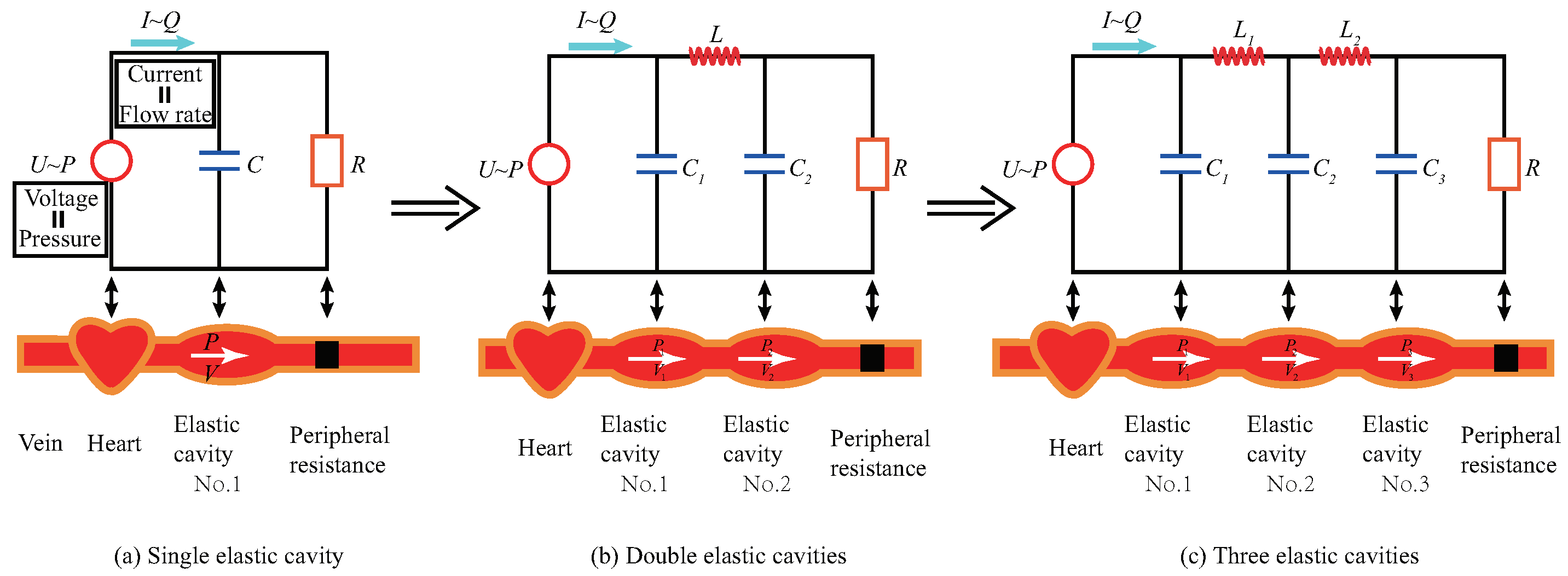
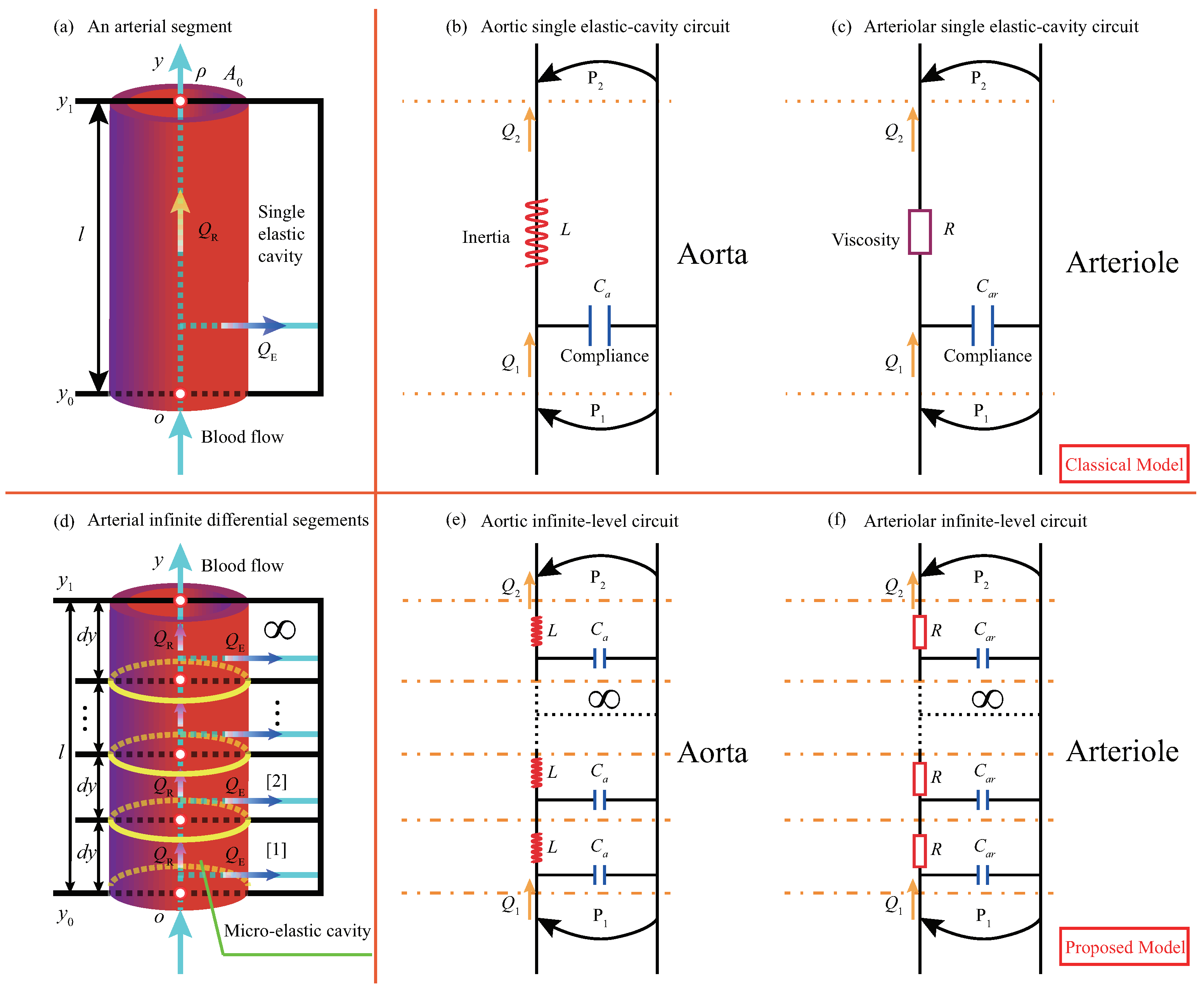



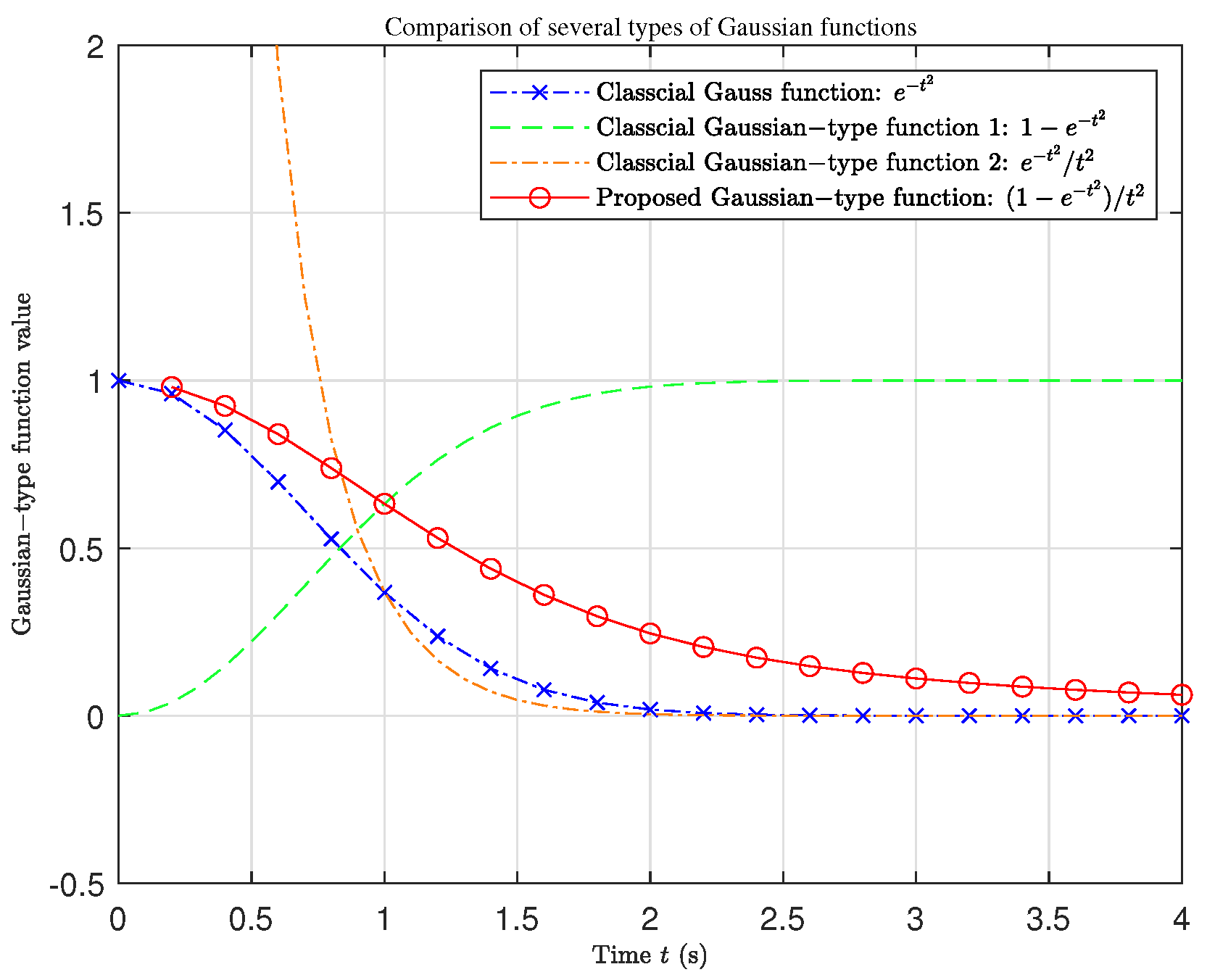
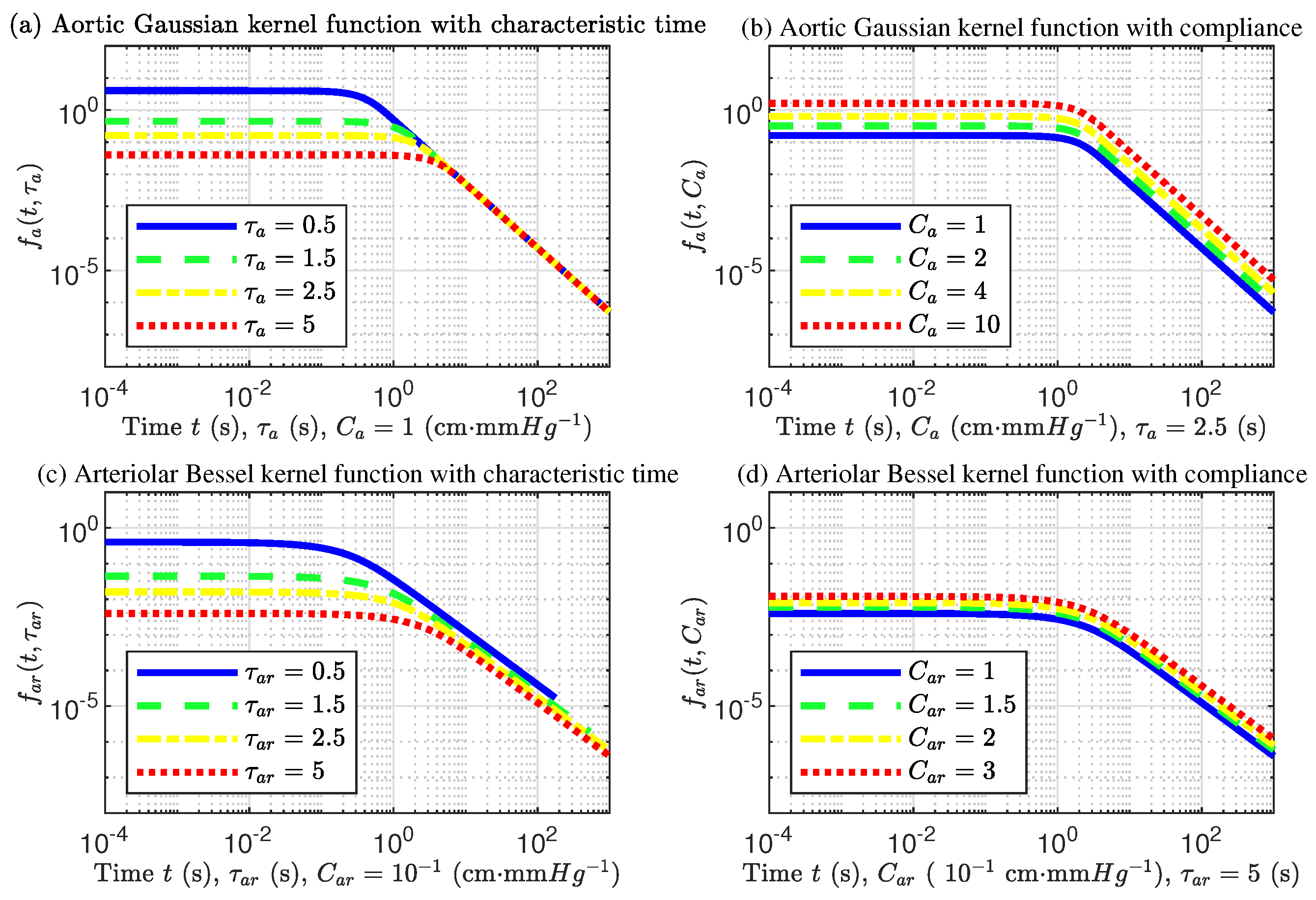
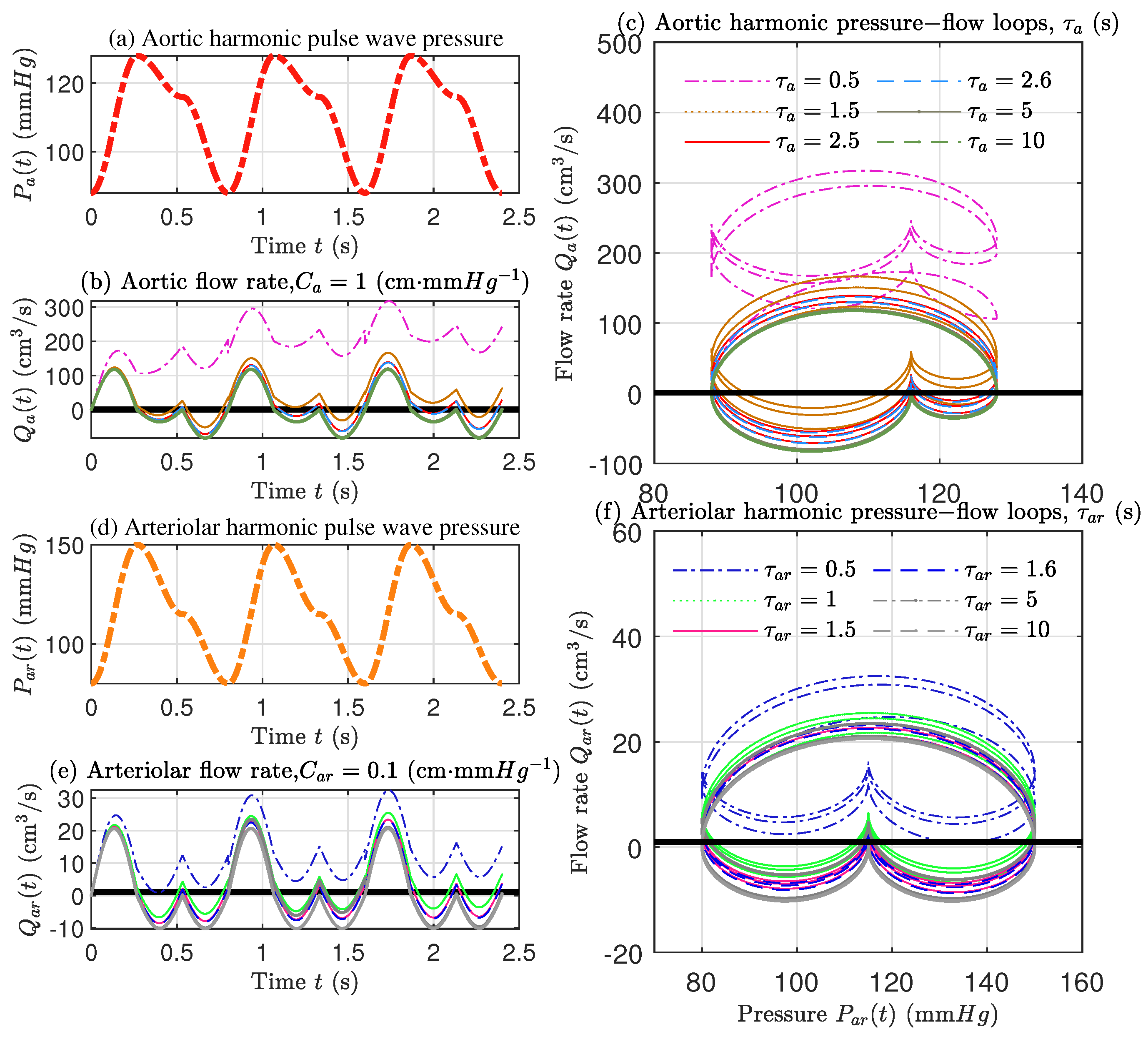
Publisher’s Note: MDPI stays neutral with regard to jurisdictional claims in published maps and institutional affiliations. |
© 2021 by the authors. Licensee MDPI, Basel, Switzerland. This article is an open access article distributed under the terms and conditions of the Creative Commons Attribution (CC BY) license (https://creativecommons.org/licenses/by/4.0/).
Share and Cite
Peng, G.; Guo, J.; Yin, Y. Self-Similar Functional Circuit Models of Arteries and Deterministic Fractal Operators: Theoretical Revelation for Biomimetic Materials. Int. J. Mol. Sci. 2021, 22, 12897. https://doi.org/10.3390/ijms222312897
Peng G, Guo J, Yin Y. Self-Similar Functional Circuit Models of Arteries and Deterministic Fractal Operators: Theoretical Revelation for Biomimetic Materials. International Journal of Molecular Sciences. 2021; 22(23):12897. https://doi.org/10.3390/ijms222312897
Chicago/Turabian StylePeng, Gang, Jianqiao Guo, and Yajun Yin. 2021. "Self-Similar Functional Circuit Models of Arteries and Deterministic Fractal Operators: Theoretical Revelation for Biomimetic Materials" International Journal of Molecular Sciences 22, no. 23: 12897. https://doi.org/10.3390/ijms222312897
APA StylePeng, G., Guo, J., & Yin, Y. (2021). Self-Similar Functional Circuit Models of Arteries and Deterministic Fractal Operators: Theoretical Revelation for Biomimetic Materials. International Journal of Molecular Sciences, 22(23), 12897. https://doi.org/10.3390/ijms222312897






